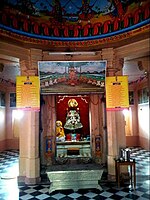Bhagat Pipa
Pipa | |
|---|---|
 Statue of Sant Pipa Bairagi | |
| Personal | |
| Born | 5 April 1425 Gagron, Jhalawar, Rajasthan, India |
| Died | Unknown (~early 15th century)[1] |
| Religion | Hinduism |
| Spouse | Rani Sita |
| Children | Raja Dwarkanath |
| Known for | 1 verse in Guru Granth Sahib. |
| Other names | Raja Pipaji Pratap Singh Rao Pipa Sardar Pipa Sant Pipaji Pipa Bairagi |
| Occupation | Ruler of Gagron |
Bhagat Pipa(born 1425[2]) was aRajputrulerof Gagaraungarh who abdicated the throne to become a Hindumysticpoet and saint of theBhakti movement.[3][4]He was born in theMalwaregion of NorthIndia(eastRajasthan) in approximately AD 1425.[5]

Pipa's exact date of birth and death are unknown, but it is believed that he lived in the late fourteenth and early fifteenth century.[1][6][7]Born into a warrior class and royal family, Pipa is described as an earlyShaivism(Shiva) andSakta(Durga) follower. Thereafter, he adoptedVaishnavismas a disciple ofRamananda,and later preached Nirguni (god without attributes) beliefs of life.[8][1]Bhagat Pipa is considered one of the earliest influentialsantsof the Bhakti movement in 15th century northern India.[8]
Life[edit]
| Part ofa serieson |
| Sikhism |
|---|
 |


Pipa was born into aRajputroyal family atGagaron,in the present-dayJhalawar districtofRajasthan.He became the king of Gagaraungarh.[3]Pipa worshipped the Hindu goddess DurgaBhavaniand kept her idol in a temple within his palace.[5]While Pipa was the king Gagaraungarh, he abdicated and became a 'sanyasi' and acceptedRamanandaas hisguru.He then joined Ramananda'sVaishnavismBhakti, a movement with a strong monist emphasis based out ofVaranasi.[8][1]In one of his works "Sri Vaishnav Dharm Mangalam" he says:
सीतारामसमारम्भां श्रीबोधनायमध्यमाम् । अस्मादाचार्यपर्यन्तां वन्दे गुरुपरम्पराम् ॥1॥ नत्त्वा रामं तथा रामानन्दाचार्य यतीश्वरम् । सर्वमङ्गलदं कुर्वे वैष्णवधर्ममङ्गलम् ॥2॥—Sri Vaishnav Dharma Mangalam[9]
According toBhaktamal,a Bhakti movement hagiography, his wife, Sita, stayed with him before and after his abdication when he became a wandering monk.[7][10]The hagiography mentions many episodes of hissannyasalife, such as one where robbers tried to steal his buffalo that provided milk to his companions. When he stumbled into the robbery in progress, he began helping the robbers and suggested that they should take the calf.[11]The robbers were so touched that they abandoned their ways and became Pipa's disciples.[11]
In his later life, Bhagat Pipa, as with several other disciples of Ramananda such asKabirandDadu Dayal,shifted his devotional worship fromsaguniVishnu avatar (Dvaita,dualism) tonirguni(Advaita,monism) god, that is, from god with attributes to god without attributes.[12][13] According to the records found with local bards, 52 Rajput chiefs from clans ofGohil,Chauhan,Dahiya,Chavada,Dabhi,Makwana(Jhala),Rakhecha,Bhati,Parmar,Tanwar,Solanki,andPariharresigned from their titles and offices and gave up alcohol, meat, and violence. Instead, those chiefs dedicated their lives to the teachings of their guru & former king.
Pipa's dates of birth and death are unknown, but the traditional genealogy in Bhakti hagiography suggests that he died in 1400 CE.[1]
Key teachings and influence[edit]
Pipa taught that God is within one's own self, and that true worship is to look within and have reverence for God in each human being.[7]
Within the body is the god, within the body is the temple,
within the body is all the Jangamas[14]
within the body the incense, the lamps, and the food-offerings,
within the body is thepuja-leaves.
After searching so many lands,
I found the nine treasures within my body,
Now there will be no further going and coming,
I swear byRama.— Sant Pipa, Gu dhanasari, Translated by Vaudeville[12]
He shared same views as Guru Nanak, the founder ofSikhism,and Bhagat Pipa's hymns are included in theGuru Granth Sahib.[6][7]
In popular culture[edit]
Shri Krishna Bhakta Peepaji(1923) byShree Nath PatankarandBhakt Peepaji(1980) by Dinesh Rawal are two Indian films about the legends of the saint.[15]
See also[edit]
- Swami Ramanandacharya
- Vaishnav Matabja Bhaskar
- Valmiki Samhita
- Maithili Maha Upanishad
- Ramanandi Sampradaya
- Bhaktamala
References[edit]
- ^abcdeRonald McGregor (1984), Hindi literature from its beginnings to the 19th century, Otto Harrassowitz Verlag,ISBN978-3447024136,pages 42-44
- ^Datta, Amaresh (1987).Encyclopaedia of Indian Literature: A-Devo, Volume 1.Sahitya Akademi. p. 79.ISBN9788126018031.
- ^abJohn Stratton Hawley (1987), Three Hindu Saints inSaints and Virtues,University of California Press,ISBN978-0520061637,pages 63-66, 53-54
- ^Max Arthur Macauliffe, The Sikh Religion: Its Gurus, Sacred Writings and Authors, Volume 6, Cambridge University Press, pages 111–119
- ^ab"Search Gurbani: Gurbani Research Website".
- ^abJames Lochtefeld, "Pipa", The Illustrated Encyclopedia of Hinduism, Vol. 2: N–Z, Rosen Publishing.ISBN978-0823931798,page 511
- ^abcdNirmal Dass (2000), Songs of the Saints from the Adi Granth, State University of New York Press,ISBN978-0791446836,pages 181-184
- ^abcDavid Lorenzen,who founded the Hinduism: Essays on Religion in History,ISBN978-8190227261,pages 116-118
- ^Pipa.Chatuḥ Samprdaya Digdarshan.p. 142.
- ^Winnand Callewaert (2000), The Hagiographies of Anantadas: The Bhakti Poets of North India, Routledge,ISBN978-0700713318,pages 277-278
- ^abWinnand Callewaert (2000), The Hagiographies of Anantadas: The Bhakti Poets of North India, Routledge,ISBN978-0700713318,page 285
- ^abWinnand Callewaert (2000), The Hagiographies of Anantadas: The Bhakti Poets of North India, Routledge,ISBN978-0700713318,page 292
- ^Michaels 2004,pp. 252–256.
- ^A term in Shaiva Hindu religiosity, referring to an individual who is always on the go, seeking, learning.
- ^Rajadhyaksha, Ashish; Willemen, Paul (1999).Encyclopaedia of Indian cinema.British Film Institute.ISBN9780851706696.Retrieved12 August2012.
Further reading[edit]
- Michaels, Alex (2004),Hinduism: Past and Present(English translation of the book first published in Germany under the title Der Hinduismus: Geschichte und Gegenwart (Verlag, 1998) ed.), Princeton: Princeton University Press
- Encyclopedia of Sikhismby Harbans Singh. Published by Punjabi University, Patiala
External links[edit]

